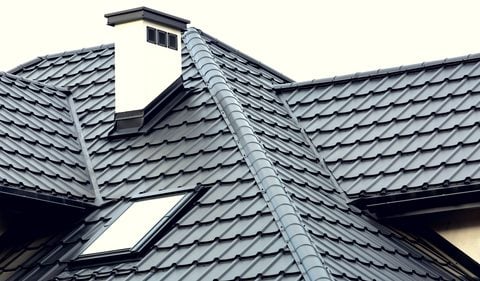The average cost of a metal roof ranges from $5,500 to $15,500, with the majority costing just under $10,500. Metal roofs are great for those seeking a long-lasting, low maintenance and eco-friendly roof, however, these roofs can be expensive, noisy and vulnerable to storm damage.
Cost factors for metal roofs
A number of factors affect what you pay for a metal roof, most notably the type of metal you choose for your roof.
|
Metal slate (stone coated slate). |
|
|
Standing seam (aluminum or zinc-coated steel). |
|
|
Corrugated metal (wavy or rippled metal). |
A copper roof.
Some additional factors that affect the cost of a metal roof include:
-
Underlayment. If your existing underlayment isn’t suitable for a metal roof, the installation of a new underlayment will increase your final cost.
-
Tax credits. Because metal roofs can be environmentally friendly, they may qualify for a tax credit, which offsets the cost of the roof.
-
Labor. Labor can make up as much as two-thirds of the cost of a metal roof. The more labor required for your roofing job, the higher your total cost.
-
Location. Regions of the country with a higher cost of living tend to have higher roof replacement costs in general. Additionally, areas with more extreme weather may be best suited to more expensive roofing materials.
-
Pitch. Roofs with a steep pitch need special equipment for metal roof installation, which can significantly raise total cost. A curved roof pitch is generally the most expensive to install, because it requires more complex and careful installation than flat surfaces do.
-
Fasteners. Hidden fasteners are typically more expensive than exposed fasteners.

Steel roof tiles.
Things to consider when shopping for metal roofs
When shopping for a metal roof, budget is a key consideration — both now and long-term. While metal roofs are typically much more expensive than shingle roofs upfront, that initial extra investment can pay off in the future. The combination of energy savings, a tax incentive and the fact that you may never have to pay for another roof for your current home all help to soften the impact of the purchase and installation costs of a metal roof.
If you live in a community with a homeowners association, you’ll also want to check to make sure that your HOA allows metal roofs. Despite all the advantages metal roofs offer, certain HOAs have reasons they won’t allow them, including:
-
Paint finishes with high glare.
-
An aesthetic that some consider “industrial.”
-
An aesthetic that’s inconsistent with the rest of the neighborhood.
Finally, be sure to read and compare warranties of the roofs you’re considering carefully before making your selection with the aim of finding the broadest coverage over the longest time period. Here are some coverage areas it’s good to have in your manufacturer warranty:
-
Substrate. Some types of metal are covered for decades, while others may not be.
-
Workmanship. This includes all the work done by the installer, such as fastener, trim and clip installation.
-
Finish/paint. This may include a length of coverage and level of color change (degradation) over time.
-
Weathertight. Weathertight coverage protects you against possible leaks in your new roof for the duration of the coverage period.
Can I get financing for a home repair or improvement?
Your contractor may offer some financing options (either through a partner or a payment plan), but there are other — any maybe better — financing options available.
Home equity loan or HELOC
Which financing option is best for me?
The best financing option for you will depend on how much money you need, when you need the money, what project you’re doing and how long you need to pay the money back. If it’s something that’ll add value to your home, a HELOC or home equity loan may be your best option because the value of your house could increase by more than the amount of the loan.
On the flip side, if it’s a less expensive repair, a credit card is probably your best option if you want to pay no interest or earn rewards. Personal loans can apply to both small and large repairs or renovations, and they may make sense if you don’t have much equity in your home.
Some home improvement contractors offer their own financing options. Before taking this option, shop around and see how their offer compares with other loans.
Regardless of what you choose, make sure you compare interest rates, terms and fees with any financing options you’re considering. This will ensure you get the best deal.
 Quicken Loans: NMLS#3030 |
||
|---|---|---|
|
NerdWallet rating
|
NerdWallet rating
|
NerdWallet rating
|
National / regionalNational |
National / regionalNational |
National / regionalNational |

